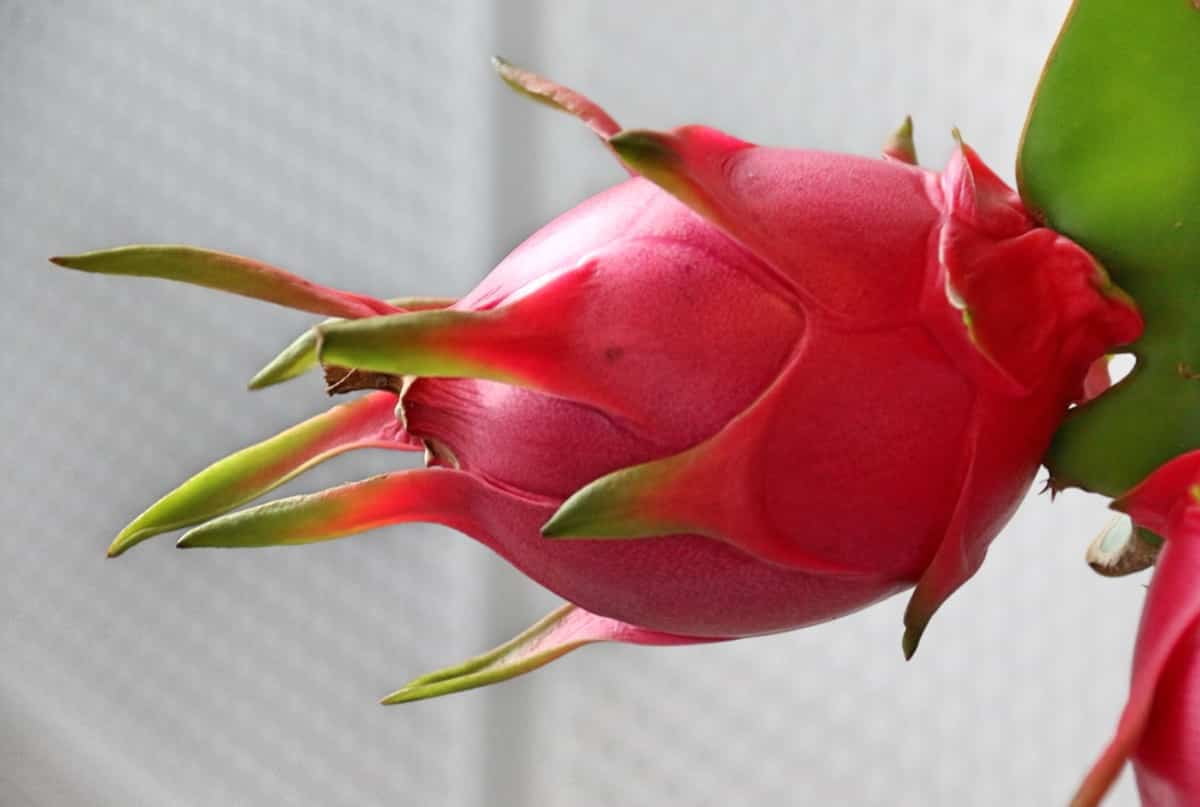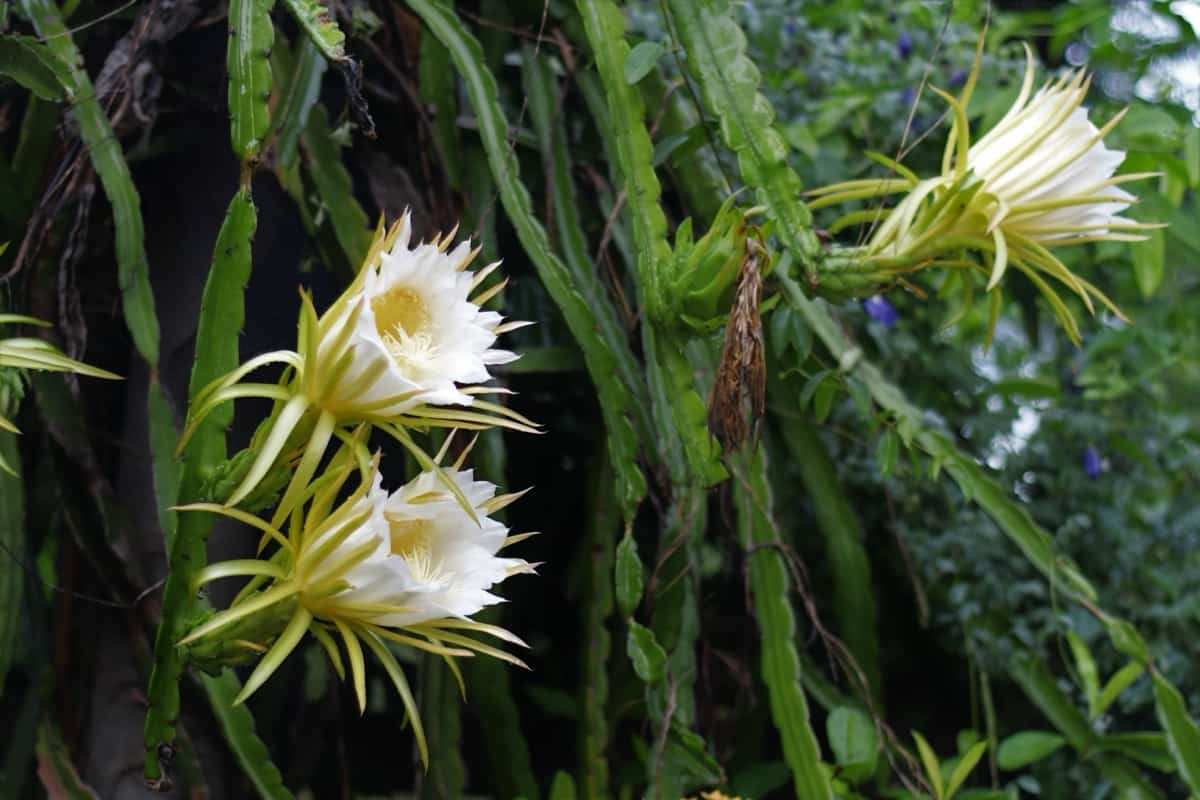Effective pest and disease management is essential in dragon fruit farms to ensure healthy and productive crops. Dragon fruit (Hylocereus spp.) is susceptible to various pests and diseases that damage the plants and reduce yield. Here are some strategies and practices for managing pests and diseases in dragon fruit farms.

Pest and Disease Management in Dragon Fruit
Importance of Pest and Disease Management in Dragon Fruit Farms
Effective pest and disease management is crucial in dragon fruit farms to ensure healthy and profitable yields. Pests and diseases can swiftly devastate crops, leading to significant economic losses. Furthermore, untreated infestations can weaken plants, making them susceptible to other stressors. This jeopardizes the overall sustainability of the farm.
Implementing proper management strategies, such as integrated pest management (IPM) and disease-resistant varieties, not only safeguards the plants but also reduces reliance on harmful chemicals. This promotes environmentally friendly practices, preserves biodiversity, and maintains high-quality produce. Ultimately, prioritizing pest and disease management is essential for the viability of dragon fruit farms.
Identifying Common Pests and Diseases Affecting Dragon Fruit Plants
- Scale Insects: These tiny insects feed on plant sap, causing yellowing and weakening stems.
- Mealybugs: Mealybugs infest dragon fruit, leading to stunted growth and damage.
- Ants: Ants protect and farm pests like aphids and mealybugs, making effective ant control important.
- Fusarium Wilt: A soil-borne pathogen that causes the plant’s wilting, yellowing, and eventual death.
- Anthracnose: This fungal disease can result in dark lesions and rot on dragon fruit, reducing its market value.
- Root Rot: Excessive moisture and poor drainage can lead to root rot, affecting the plant’s overall health.
- Botrytis: A grey mold that affects flowers and fruit, leading to spoilage.
Implementing Integrated Pest Management Strategies for Dragon Fruit Farms
IPM combines various approaches to minimize pest impact while reducing chemical pesticide use. Farmers can use beneficial insect release, crop rotation, and habitat manipulation to control pests naturally. Regular monitoring and early pest detection are key to enabling timely intervention.
In case you missed it: 10 Common Mistakes to Avoid in Dragon Fruit Farming

Employing disease-resistant cultivars and practicing good cultural techniques like proper spacing and irrigation can bolster plant health. Education and training for farmers on IPM practices are essential to ensure effective implementation, safeguarding both the environment and the long-term productivity of dragon fruit farms.
Cultural Practices in Pest and Disease Management in Dragon Fruit Farms
Proper spacing between plants and adequate ventilation reduces humidity, making the environment less favorable for pests and pathogens. Pruning and regular maintenance help remove infected or weak plant parts, minimizing the spread of diseases. Implementing effective drainage systems prevents waterlogged soil and root rot.
Crop rotation reduces the buildup of soil-borne pathogens. Furthermore, maintaining cleanliness on the farm, disposing of plant debris, and keeping weeds in check all deter pests and diseases. These practices collectively create a healthier growing environment, reducing the need for chemical needs and promoting sustainable dragon fruit cultivation.
Techniques for Early Detection of Pests and Diseases For Pest and Disease Management in Dragon Fruit Farms
- Regular Scouting: Conduct frequent field inspections to identify any signs of pests or diseases. Look for abnormal growth, discoloration, or pests on plants.
- Traps and Monitoring Stations: Set up pheromone and sticky traps to capture and monitor specific pests. These provide valuable data for timely intervention.
- Use of Beneficial Insects: Introduce natural predators like ladybugs or lacewings to control pest populations. They help maintain a balanced ecosystem.
- Weather and Environmental Monitoring: Stay aware of weather conditions and temperature trends, as they can influence pest and disease activity.
- Utilize Technology: Implement sensors, drones, or remote sensing technology to monitor the farm’s health and detect early signs of stress.
Utilizing Biological Control Agents for Sustainable Pest and Disease Management in Dragon Fruit Farms
- Predatory Insects and Parasitoids: Release or encourage natural predators like ladybugs, lacewings, or predatory mites to control pest populations.
- Microbial Inoculants: Apply beneficial microorganisms like entomopathogenic fungi or nematodes that target specific pests, keeping their populations in check.
- Beneficial Nematodes: These microscopic organisms, such as root-feeding nematodes, can control soil-dwelling pests.
- Encourage Natural Predators: Create habitats like hedgerows or plant diverse crops to attract and support beneficial insects and birds.
In case you missed it: Best Practices for Planting Blueberry Bushes: Tips and Techniques

Choosing the Right Pesticides for Targeted Pest and Disease Management in Dragon Fruit Farms
- Selective Pesticides: Opt for pesticides targeting the identified pest while minimizing harm to non-target organisms.
- Low Toxicity Options: Choose pesticides with low toxicity to beneficial insects, animals, and humans, prioritizing environmentally-friendly options.
- Rotate Pesticides: Employ a rotation strategy to prevent the development of pesticide resistance in pests.
- Follow Label Instructions: Adhere strictly to the recommended dosage, application timing, and safety precautions to ensure effective and safe pesticide use.
- Consider Alternative Treatments: Explore non-chemical alternatives like neem oil, insecticidal soaps, or horticultural oils for pest control.
Quarantine Measures to Prevent New Pest and Disease Management in Dragon Fruit Farms
Implementing robust quarantine measures is essential to prevent the introduction new pests and diseases to dragon fruit farms. Strictly control the movement of plant material onto the farm, conducting thorough inspections and ensuring the source is disease-free. Isolate and monitor new plantings for quarantine to detect and manage potential threats. Educate staff about the importance of biosecurity to maintain the farm’s health and prevent the spread of exotic pests and diseases that could jeopardize dragon fruit production.
Developing a Crop Rotation Plan to Minimize Pest and Disease Management in Dragon Fruit Farms
Crop rotation is a vital strategy to reduce the buildup of pests and diseases in dragon fruit farms. It involves periodically changing the location of dragon fruit crops within the farm. By planting different crop species in previous dragon fruit areas, pests and diseases specific to dragon fruit have a reduced host environment, thus decreasing their populations.
A well-structured crop rotation plan enhances soil health, minimizes the need for pesticides, and maintains overall farm productivity. Choosing suitable rotational crops and following recommended cycles is crucial to sustainably managing pests and diseases.
Frequently Asked Questions Dragon Fruit Pest and Disease Management
What are the Pests Of Dragon Fruit?
- Mealybugs
- Scale insects
- Aphids
- Red spider mites
- Fruit flies
- Ants (as they protect and farm certain pests)
What Is the White Insect In Dragon Fruit?
The white insect in dragon fruit is typically a scale insect known as the “pitaya mealybug”, which infests the fruit’s skin. These insects feed on the plant’s sap and secrete a white, waxy substance that can cover the fruit’s surface, making it appear dusty or moldy.
In case you missed it: Step-by-Step Guide to Establishing a Dragon Fruit Farm

How Do You Control Dragon Fruit Diseases?
Practice sanitation by removing and disposing of infected plant parts, providing proper spacing between plants for air circulation and avoiding overwatering. Use organic fungicides when necessary, and ensure the dragon fruit plants receive adequate sunlight and well-drained soil to prevent disease development.
What is the Fungus Infection in Dragon Fruit?
Fungus infections in dragon fruit, often caused by pathogens like Colletotrichum or Bipolaris, can lead to symptoms such as dark lesions, rotting, and decreased fruit quality. Proper cultivation practices, including adequate spacing, good ventilation, and fungicide applications, can help manage and prevent these infections.
Can Fungicide be Used to Treat Dragon Fruit?
Fungicides can treat dragon fruit plants when fungal diseases, such as anthracnose or stem rot, are present. These products can help control and prevent fungal infections by applying them according to the manufacturer’s instructions. It’s essential to follow safety guidelines.
What Is the Best Pesticide for Dragon Fruit?
The best pesticide for dragon fruit depends on the specific pests you are dealing with. Common options include neem oil, pyrethrin-based insecticides, and organic solutions like diatomaceous earth.
Conclusion
In conclusion, effective pest and disease management is the linchpin of successful dragon fruit farming. By reducing reliance on pesticides, safeguarding crop health, and preventing new infestations, farmers ensure the longevity and sustainability of their dragon fruit farms while promoting environmental stewardship and robust, high-quality yields.
- Feed Your Flock for Less: Top 10 Tips to Save on Chicken Feed
- Ultimate Guide to Ossabaw Island Hog: Breeding, Raising, Diet, and Care
- Hatching Answers: The Top 10 Reasons Your Chickens Aren’t Laying Eggs
- Eggs and Economics: Breaking Down the Cost of Raising Backyard Chickens
- Defend Your Greens: Proven Methods to Keep Iguanas Out of Your Garden
- Ultimate Guide to Cinnamon Queen Chicken: A Comprehensive Guide for Beginners
- Ultimate Guide to California Tan Chicken: Breeding, Raising, Diet, Egg-Production and Care
- Ultimate Guide to Marsh Daisy Chicken: Breeding, Raising, Diet, and Care
- 10 Types of Chicken Farming Businesses You Can Start for Profits